|
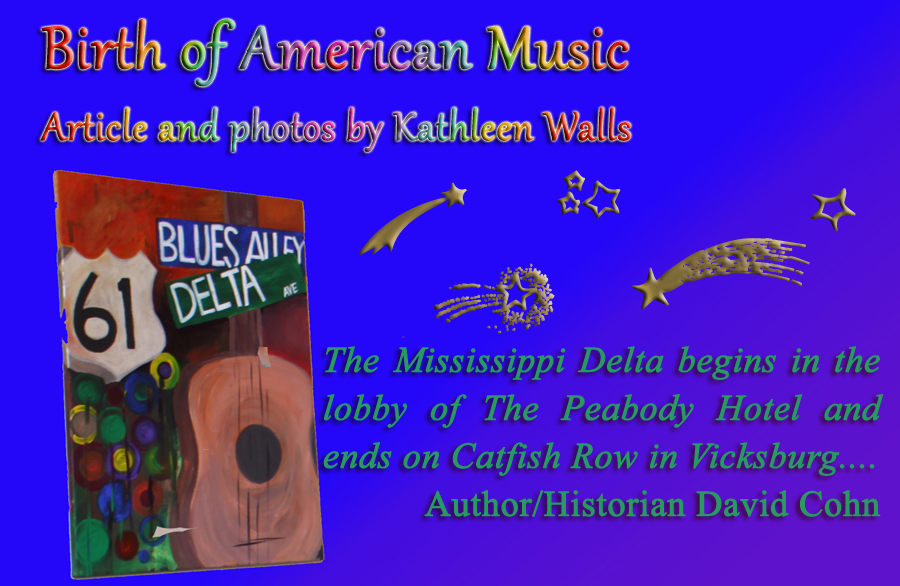
The music of America was born in the
Mississippi Delta. It was firmly rooted in the alluvial topsoil
that the "Father of Waters" spewed across the land as it
regularly overflowed its banks wreaking havoc on anything in its
path. After mankind learned to tame the mighty river with
levees, they realized the bounty the rampaging Mississippi had
given them. This land is
one of the richest agricultural areas in the world. Almost
anything will grow here; cotton, soybeans, corn and vegetables
of almost any kind. Once upon a time, in the not too distant
past, the Mississippi Delta ran on a system where the richest
people in the country owned the land and the crops and some of
the poorest worked the fields to produce their bounty. In that
era, cotton was king. But this system produced one other
important product, American music.
This is the
land where the Blues were born. And from the Blues, evolved so
much more of our other music. Country, Rock and Roll and even
Motown and Jazz were all influenced by the Blues. The Civil War
and 13th amendment might have legally freed African Americans
but economic slavery and gross inequality was still the way of
life. The Blues were a cry from the soul of men and women who
worked the fields from "cain't to cain't" referring to "cain't
see in the mornin' 'cause it's too early 'til cain't see at
night 'cause it's too late." They had little recourse from the
law when they were misused and abused by their employers and any
other white men who felt the need to "prove their superiority"
at the expense of the lowly cotton pickers or farm workers. So
they poured out their souls in music on the fields and in the
ramshackle jook (later evolved into juke as in juke box) joints
where they took what pleasures they could at night after their
day's labor.
 |
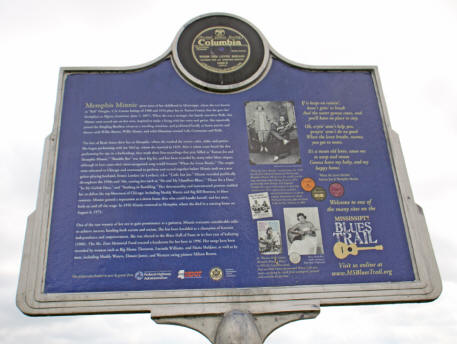 |
| Blues Trail signs
recognizing Memphis Minnie |
Today, the
portion of Highway 61 that runs from St. Louis, Missouri to
Memphis, Tennessee, through the Mississippi Delta, and on to New
Orleans is known as "The Blues Highway." The state of
Mississippi has created a Blues Trail with over 150 markers and
growing to honor those who contributed to the birth of the
Blues. (They also have a County Music Trail that often
overlaps.) As you drive into Mississippi from Memphis you soon
find the markers. One of the first we visited was the grave of
Memphis Minnie. It's located in Walls at the New Hope Church
Cemetery. Memphis Minnie, whose real name was Lizzie Douglas,
moved to Walls as a teen. She followed the lure of fame to
Memphis and gained prominence as one of the few female Blues
guitar players.
I have visited the Delta twice and
found museums and
heritage centers that celebrate the Blues unique musical
expression. One I especially enjoyed was the Gateway to the
Blues Museum located at Tunica Visitors' Center. Any music lover
will adore this museum and even those with only a mild interest
will be fascinated.
It is filled with artifacts that tell
the story of how the Blues began. There are lots of guitars
tracing the history and evolution of the instrument. It has
exhibits with images and instruments for most of the better
known Mississippi Delta Bluesmen such as Howlin' Wolf, Muddy
Waters, Son House, Robert Johnson, Charlie Patton, Sonny Boy
Williamson, Jimmy Reed, one of the few white Bluesmen, and many
others. You can spend hours there. It's great fun and so
enlightening. One of my favorite options this museum offers is a
chance to record your
own Blues song. Go there and record you own Blues like I
did. Hopefully you can sing better than I do.
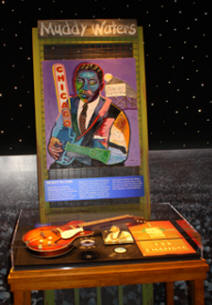 |
 |
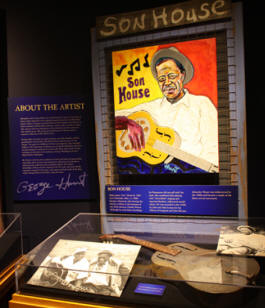 |
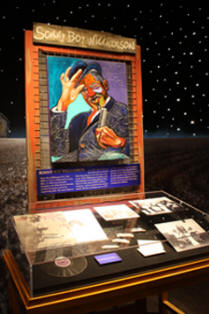 |
| Some of the Blues
legends and their artifacts displayed at Gateway to the
Blues Museum |
The Blues
has features of its African heritage and the slave songs, work
chants and field hollers, sung
on the plantations by a people yearning for freedom. It also has
a form of the Call and Response consisting of a 12-bar pattern
with an AAB format that was a common practice in African
cultures. AA, the call,
is repeated in the first two lines of the song sometimes with
some variation, and B is the response.
A perfect example of this format is found in Robert Johnson's
"Crossroads Blues"
I went to the crossroad fell down on my
knees
I went to the crossroad fell down on my knees
Asked
the Lord above "Have mercy, now save poor Bob, if you please."
One of the best known legends about the
Blues is the story of how Robert Johnson sold his soul to the
Devil to become a
talented Blues Musician. The story goes that Johnson saw the
Blues as a way out of the poverty of a subsistence farmer. He
became a follower of Son House, already a legendary Bluesman,
House told Johnson he showed no talent with his guitar playing.
Johnson left for a few months. Got married and moved to a farm.
When he returned to see
his mentor again, he was a fantastic player and no longer had a
wife. Son House offered the explanation that Johnson must have
"sold his sold to the devil at the crossroads" in exchange for
his newfound talent. (You will find a marker to Son House at
Tunica.)
The legend
sites several places where the transaction took place. Of
course, we had to go look for ourselves. The generally accepted
spot where the deal with the Devil took place is the crossroads
of Hwy 61 and 49. There is a Blues Marker there and a great
photo op with the crossroads sign.
However, that might be too simple. There
are many other theories as to the actual crossroads of Robert
Johnson's life. We visited the Tunica Museum and met Dick
Taylor, the executive director. The museum has a lot of exhibits
representing the way of life that produced the Blues. My
favorite is Sally the Mule.
You have to see Sally to appreciate Dick's story about
her origins.
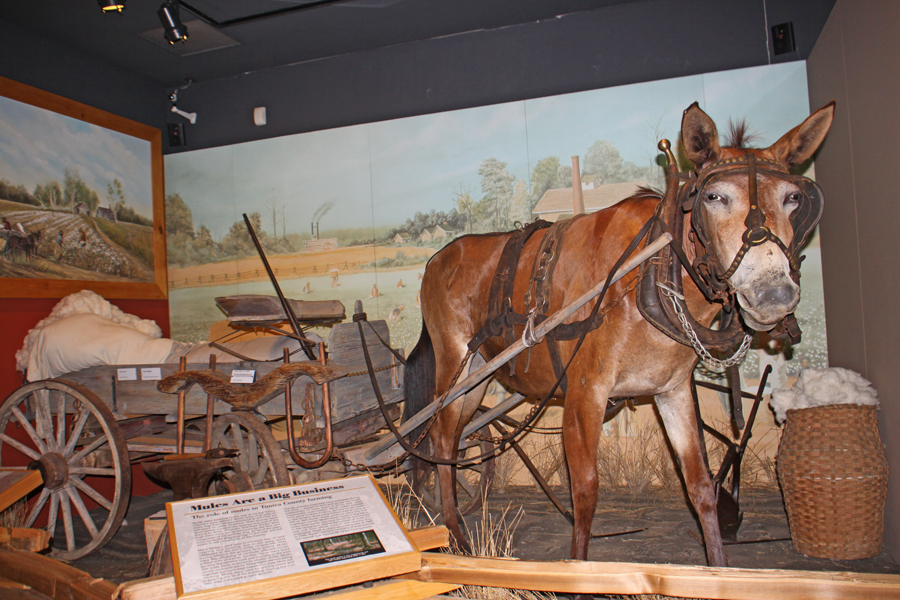 |
| Sally the Mule represents the
importance of the mule to Delta farmers. |
Dick had
his own opinion about the site of the actual crossroads. He
stated, "Robert Johnson grew up around here. I was lucky enough
to know people who knew him as a child. Wayne Cooper who lived
and worked and grew up with Robert Johnson said for the most
part the story is true but the Crosstown Cemetery is the actual
place where Johnson made his deal."
Dick also pointed out that the Devil
would usually be found near water and this cemetery is right
near the Mississippi River at the intersection of Crosstown Road
and Bonny Blue Road, not
too far from the museum so we trekked out there.
Dick had told us every one he sent out
there came back with a strange story. They varied from car
radios changed and
played stations the owner had never heard before, car air
conditioners went out. My own experience was my camera battery
going dead at that point and repeating the
problem at several spots related to Robert Johnson.
Johnson went on to be called the "Father
of the Blues." He used various aliases and pretty much had a
woman in every town to which he traveled.
Johnson's life was cut short at the age of 27 when he was
reputedly poisoned while playing a jook joint by a jealous
husband.
Much of
Johnson's life is obscured with myths. Even his exact burial
place is debated. There are three gravestones around the area
claiming to be his final marker. On a previous trip I visited
one grave that the locals believe is the actual site. There was
an eyewitness to Johnson's burial here, one of his former girl
friends. It is located in Little Zion Baptist Church Cemetery.
The Blues Trail marker is located nearby. His birthplace marker
is located in Hazlehurst.
Clarksdale
has much more of the Blues heritage besides the infamous
crossroads sign. The Rock ‘n' Blues Museum is filled to
overflowing with memorabilia covering over 50 years of music.
Theo Dasbach, museum owner and himself a musician, fell in love
with the Blues as a child in Luxemburg, Netherlands. If you want
to examine everything in the museum you could be there for days.
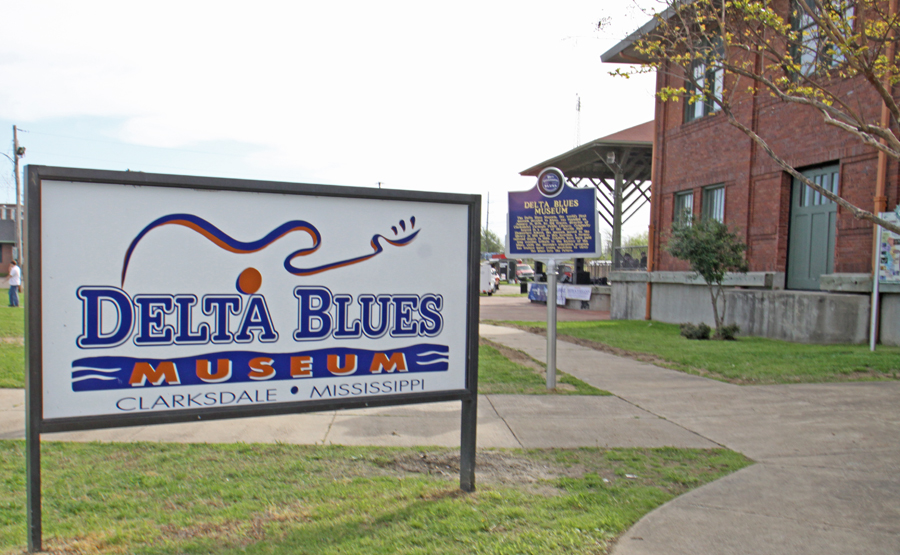 |
| |
Another
Clarksdale must see spot is the Delta Blues Museum. It is filled
with information and artifacts of the legendary Blues musicians
and many lesser known ones. For me the highlight of the museum
is the cabin where Muddy Waters lived when he worked as a
sharecropper and tractor driver at Stovall Farms. It was on the
front steps of this very cabin that Alan Lomax, the
ethnomusicologist credited with saving many of the songs of the
Delta, recorded Muddy on the front porch of this shack for the
Library of Congress in 1941. Muddy Waters has markers at the
site of the cabin's original location on Stovall Plantation near
Clarksdale and at his birthplace in Rolling Fork.
Want a unique place where you can stay,
dine and hear some great Blues musicians? Ground Zero has it
all. (See
more )
While we were visiting Clarksdale the
Juke Joint Festival was in full swing. (For
more about this see Street Party)
Clarksdale
considers itself the epicenter of the Blues. It has nine Blues
Trail Markers including one for WROX at 257 Delta Avenue, the
site of Clarksdale's first African American radio station. WROX
featured the famed "King Biscuit Show" and musicians like Ike
Turner and Robert Nighthawk.
Ike Turner was born in Clarksdale.
Performing with his former wife, Tina Turner, they
achieved worldwide fame and have been inducted into the Rock and
Roll Hall of Fame. Ike is also in the Blues Hall of Fame. His
marker is in Clarksdale at the site
of Hotel Alcazar, where Turner worked as a youth.
 |
| |
If you are interested in the typical
life of the earlier Blues players,
Dockery Farms, midway between Clarksdale and Indianola,
is the place to visit. It was the home of many of the Blues
greats. Charlie Patton, Robert Johnson Howlin' Wolf, Pops
Staples and Honeyboy Edwards all resided and worked at Dockery
Farms at one time. This was a typical plantation of
the time. It has a marker on the Blues Trail. You can
visit and do a self tour or request a guided tour.
One famous
Bluesman who is just passed is legendary B. B. King. Indianola
is where most of the markers related to him can be found. The
greatest find there is the B. B.
King Museum and Delta Interruptive Center. This museum
chronicles King's life from his childhood through his days as a
sharecropper and tractor driver to becoming "The King of Blues."
It's a must see stop on the Blues Trail.
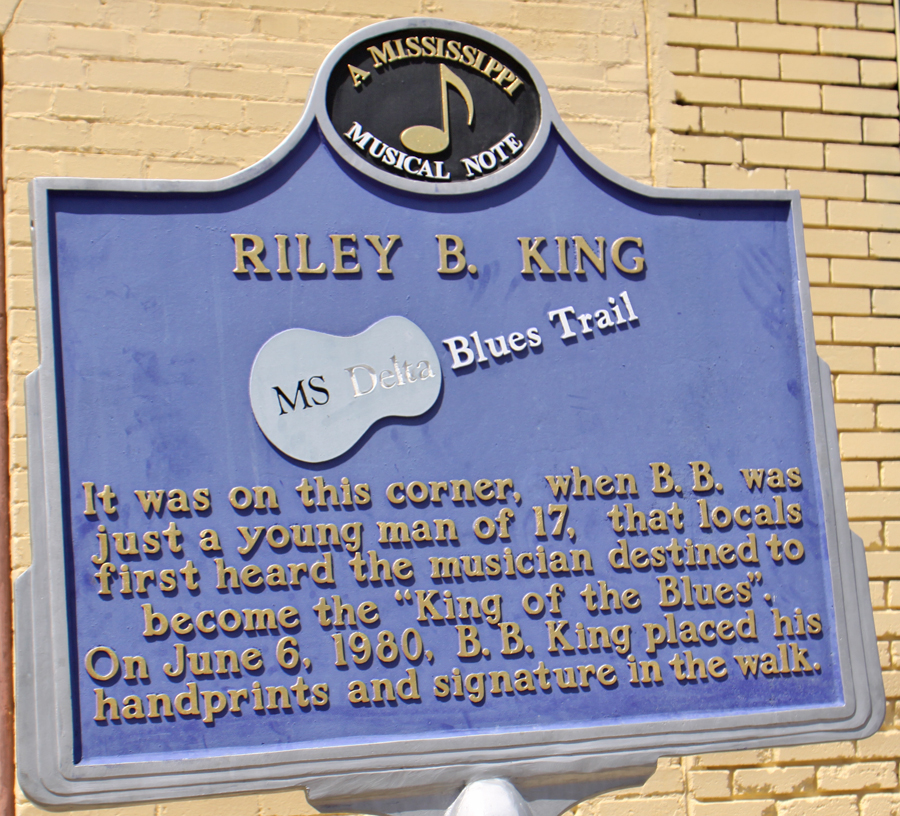 |
| |
The marker on the corner of Second and
Church Street in Indianola where B. B. King would hang out and
play for tips as a teenager is sort of the grandfather of the
Mississippi Blues Trail. It along with a sister marker at Club
Ebony later replaced by the "official" Blues Trail Marker, was
done as an effort to convince the state of Mississippi to move
forward with a Blues Trail project.
Besides the marker, B.
B. King had
engraved his handprints and name into the cement. There is also
a image of his guitar, Lucille, and a portrait of young Riley B.
King before he went to Memphis and acquired the name he is known
worldwide by today, B. B. King. The "B. B." was short for Blues
Boy, a nickname he earned while playing in Memphis.
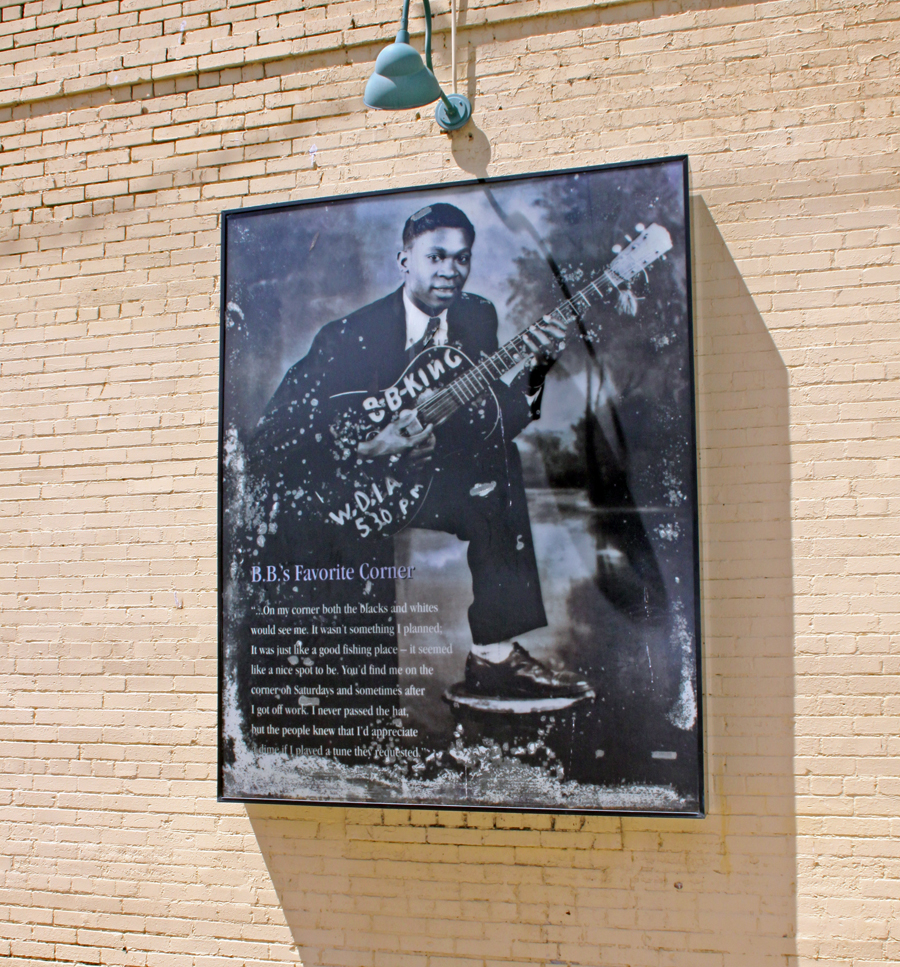 |
| |
This marker was placed in June of 2003,
well before the first official marker for the Mississippi Blues
Trail was installed on
December 11, 2006. You will notice this marker is slightly
different from the others and refers to a "Mississippi Delta
Blues Trail" that the project was originally conceived to be.
B.B. King along with then Governor Ronnie Musgrove attended the
unveiling.
There is a
marker for Church Street itself which was then the center of
African American life. Ironically there is another marker in
Indianola for Club Ebony. Club Ebony was a highly influential
venue for African American musicians. It was also where he met
his second wife, Sue Carol Hall, the then club owner's daughter.
B. B. King later purchased the club so that it would always keep
the tradition alive.
Before he
went to Memphis and achieved a name for himself, B. B. King
played with St. John's Gospel Singers of Inverness broadcast on
Sundays from WGRM in Greenwood.
There is a museum dedicated to the life and death of Robert
Johnson, The Greenwood
Blues Heritage Museum. The marker commemorating WGRM stands just
outside Delta Bistro. I can vouch for the great food and unique
atmosphere there. It's a great place to dine after your Delta
travels. Have the Tin Roof Sunday if you can save enough room
for dessert.
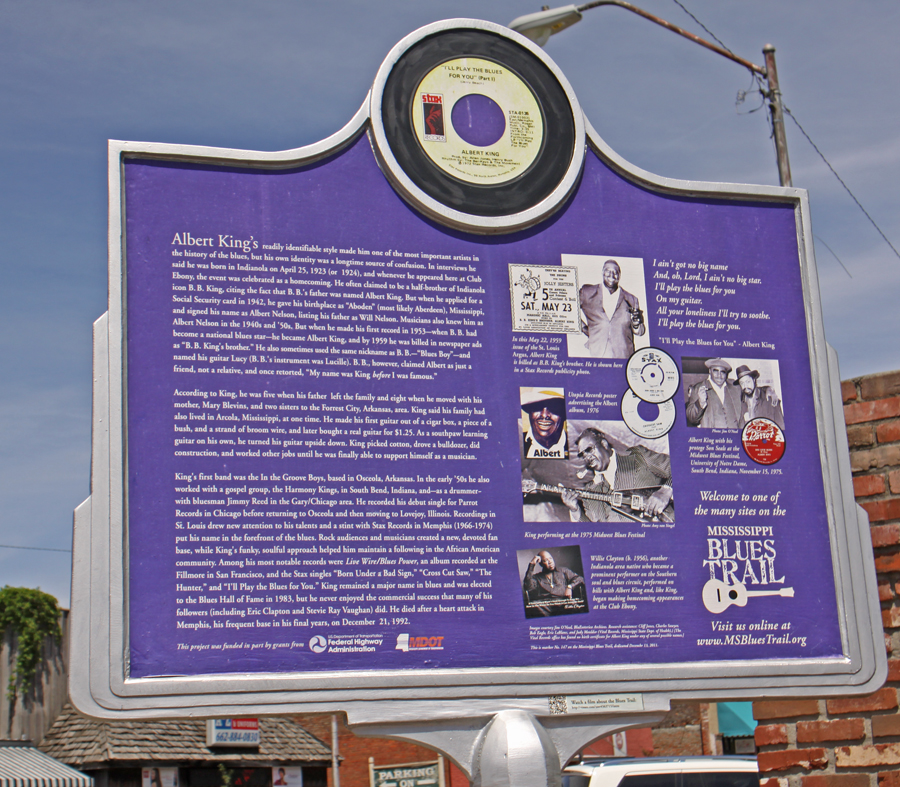 |
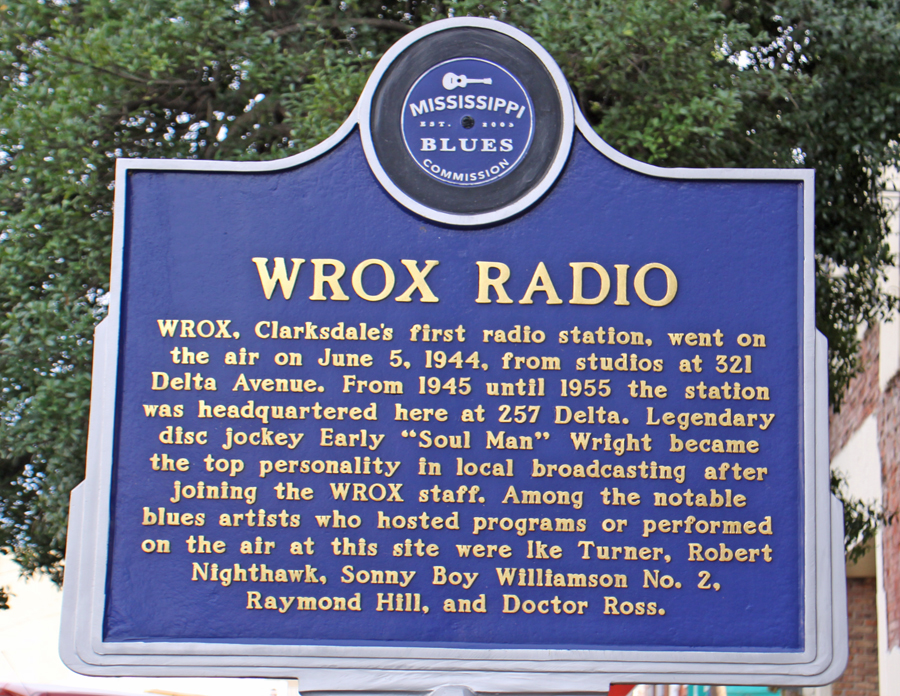 |
| The Albert King Blues Marker in
Indianola |
WROX Radio Marker in Greenwood |
We finished
off our Delta Blues tour with a bit of wine at the Winery at
Williams Landing. This is the only winery in the Delta. Lonnie
Bailey, the owner and winemaker, uses mostly Mississippi
products. Four of his wines, the Harmony Series are named for
and celebrate the heritage of the Blues. My favorite is an
unusual fig wine called Delta Dew.
There is little doubt and much evidence
that Country Music was highly influenced by the Blues. Jimmie
Rodgers, known as the "Father of Country Music" also had
another nickname, "The Blue Yodeler." Much of his music had
elements of the Blues. There is even a Jazz connection as Louis
Armstrong played trumpet in Jimmie Rodgers' "Blue Yodel #9." (for
more about Jimmie Rodgers) Rodgers was posthumously inducted
into the Blues Hall of Fame in 2013. This blending of generas
ran both ways.
Howlin' Wolf tried
to copy Rodgers but
admitted, "I couldn't do no yodelin', so I turned to howlin'.
He did quite well with
that.
No question that Rock and Roll grew out
of the Blues. "Rocket 88" is often credited with being the first
Rock and Roll song. (Others
credit Elvis's rendition of "Blue Moon of Kentucky.")
The vocal was Jackie
Brenston, Ike Turner's saxophone player in Turner's
Kings of Rhythm. Ike
Turner was unofficially the writer of
"Rocket 88" but
the recording was credited "Jackie Brenston and His Delta
Cats" because Sam Phillips, the producer who later founded Sun
Studio, wanted to release a different record credited to Turner.
The Blues
are responsible for another form of music. Many of the African
American Bluesmen and women migrated north to find work in
factories. They brought their music with them but here in big
cities where they played to large audiences, the sound needed
something more. The acoustic guitars gave way to electric
guitars and singers now used microphones. One city with an
abundance of factories was Detroit. No one can deny that Motown
Music of the 50s and 60s had elements of the blues. (For more
about Motown music see
http://www.americanroads.net/renees_route_winter2015.htm)
Everyone
should visit the Delta at least once and follow the Blues Trail.
It's said that in the Delta, the wind blows all the time. If you
listen carefully you may hear notes of the Blues in the rustling
of the tree leaves and stirring of the long grasses. Perhaps the
spirit of the long gone Bluesmen still echo there.
For more
info:
http://www.msbluestrail.org/
http://www.tunicatravel.com/things-to-do/the_blues/gateway
https://www.deltabluesmuseum.org/
http://www.blues2rock.com/Blues2Rock/index.htmll
http://www.dockeryfarms.org/
http://www.bbkingmuseum.org/
http://www.groundzerobluesclub.com/
|